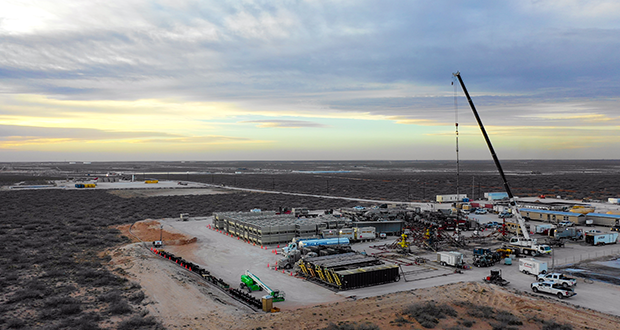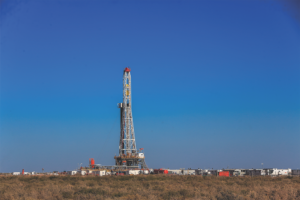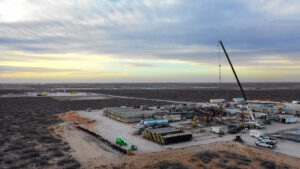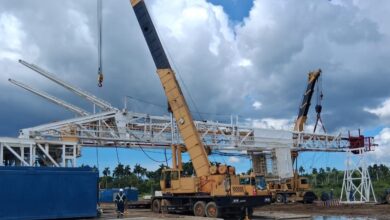To succeed in shales, learnings must be scaled quickly so wells are not just best-in-class but repeatable

Shell’s Cindy Taff: Data and real-time centers can help to achieve this by allowing best practices to be widely applied, regardless of individual experience at well site
By Linda Hsieh, Editor & Publisher
Cindy Taff is VP Unconventional Wells & Logistics for Shell.
From your role at Shell, what do you see as the biggest challenges that the drilling industry faces in 2020 and beyond?

Two challenges come to mind. The first is the reputation of the industry. It is our license to operate, and it impacts our ability to attract and retain staff. I think that we have to work even harder to reduce greenhouse gas emissions and develop alternative energy sources. We really have to be much more proactive about what we’re doing within the energy transition.
The second challenge is to continue to find ways to be more efficient at developing hydrocarbons so that we can meet society’s energy needs. This means that, as an industry, we need to work together to increase productivity and eliminate waste in the system. Especially in areas that don’t represent a competitive advantage like safety, we have a huge opportunity to improve by working together.
What do you see as the barriers to be able to collaborate more effectively?
Part of it is that we work in a lot of remote places, and part of it is that we all think we have unique challenges in different wells and different basins. In addition, we have these cycles where the market goes up and down, which doesn’t create the best environment for competing companies to work together.
You’ve said before that shale drilling has evolved from art into science. Can you elaborate on what that means?
What I was trying to say is that drilling is no longer just reacting to what Mother Nature puts in front of us, and it’s not best delivered through rules of thumb or the experience of any one individual on the rig. Instead, there are a lot of levers that we can pull to improve performance.
At Shell, we look at what we call best composite well cost, so we’re designing wells and measuring success by each section of the well. This allows us to strive to deliver the best composite well cost when it’s all put together. In addition, we’re also designing and executing wells through remote operating centers, so we’re literally optimizing our well execution on a foot-by-foot basis, whether it’s designing the BHA, mud, rotary speed, weight on bit, etc.
In the real-time operating center, we track the subsurface lithology so we can compare – in real time – how our approach to drilling mechanics works in specific subsurface lithologies. The real-time operation center also allows us to immediately share learnings between wells, basins and countries.
This has allowed us to quickly implement best practices across all of the rigs in our portfolio. For example, we use the real-time operating center in Canada to drill wells in Argentina because the subsurface is similar in both places.
So going back to your question, what I meant was that drilling is no longer an art that’s left only to the driller or the companyman, and we’re not making decisions in a silo about what to do next on a well, nor targeting only incremental improvements.
Combining real-time operating centers with other levers that we’re pulling, step-change improvements are within our reach.
Does this mean there’s less room for out-of-the-box thinking, if you’re relying so much on data instead of individuals?
Not at all. When you think about who are some of the most creative out-of-the-box thinkers, they’re actually scientists. What we’re trying to do is apply scientific principles to create value in our wells operations.
I’ll give you an example. In the Permian, we drilled the world’s first horseshoe well. This means that we drilled the lateral section, turned 180° and drilled another lateral in the same wellbore. To do that required out-of-the-box thinking, but it also required scientific analysis to make sure we could make that turn and to ensure the equipment would work.
Have you seen any resistance, either from the people who design or drill wells, who feel like their experience or knowledge should be more valuable?
That can be a challenge, because we do hire people for their experience. What I would say is that what we’re trying to do in shales is to not only deliver best-in-class wells but to do so in a manufacturing mode. Being able to repeatably deliver best performance is critical to success in the shales business and requires knowledge and tools that go beyond an individual.
Consequently, we need to set expectations – for both operators and contractors – that decisions will not always be made at the well site. Our real-time operating centers are quickly learning from the data on all of our rigs and then sharing learnings across drill units, basins or even countries. We need to adapt our people to that way of working.
Obviously, some decisions will always be made at the well site, such as those relating to process or personal safety, but a lot of optimization decisions will be made away from the well site.
As the industry continues to digitalize and automate, what are some of the growing pains that companies are experiencing as they learn to maximize the value of data?
Obviously, data enhances the quality and speed of decision making. However, it’s not a substitute for technical or operational knowledge or experience. It’s better when you can pair the digital technology with staff who know how to apply it effectively. They can then provide feedback on the technology, which can be used to quickly make changes for increased effectiveness. The experience of end users of digital technology will then continue to get better, and we can achieve full value from that technology. Bottom line, we have to work more nimbly when it comes to digital technologies.
Another area where we need to improve is articulating the business value of digital technologies. Digital technologies can’t be “done” to people in the field; you really need to capture their hearts and minds. They have to be able to understand the business value to fully support it.
What have been some of the biggest lessons learned from previous wells that you’re using to improve current/future well completions?
I would say that we’ve made huge improvements in surface efficiencies in both drilling and completions. We drill and complete almost 200 wells per year, so delivering on safety and well unit cost, as well as the pace of the wells, is critical.
Because of the importance of delivering in manufacturing mode, when we focus on frac stages per day or footage drilled per day, our efficiencies are also complementing the contractor’s efficiency.

In terms of how we design our completions, I would say that we’ve learned a lot of lessons around what we call the parent-child well relationships and how they’re affected by things like well spacing.
We’ve also learned a lot about how to more effectively distribute the frac across the formation. Much of that depends on Mother Nature, so we have to understand how different approaches – like how you design your limited entry perforating across stages or your pump rates – can optimize what’s happening downhole. The measure of success is ultimately the productivity of the well.
Where do you see the next step changes in unconventional well completions coming from?
We’re starting to take a system analysis approach across multiple functional boundaries, such as planning, drilling, completion, artificial lift and installation. This end-to-end analysis helps us to test interdependencies and highlight where the true value is gained in efficiencies and cycle time. It’s kind of a natural progression from the way we work now, which is optimize, eliminate waste and leverage best practices.
We think this will really allow us to push the boundaries of what is possible, which we call our technical limits. We believe there is an opportunity to reduce cost by 25% to 35% without impacting frac intensity, which is important because that’s what impacts well productivity.
I assume that Shell has taken a lot of lessons learned from US/Canada uncon-ventionals to improve its work in Argentina, but are there any lessons learned in the Vaca Muerta that could be applied back in North America?
We’ve learned a lot about safety management from our wells operations in Argentina. For example, we have a program called Assist and Assure and another one called Own the Zone, and our Argentina team has done an exceptional job putting those programs in place and making them consistent between rigs and frac units.
Argentina has also done a great job increasing the number of frac stages pumped per day. We set a record in Argentina recently when we pumped 11 stages in less than 24 hours, a clear indication we are leveraging best practices there.
But I think we have to recognize that the industry in Argentina is still immature compared with North America. As they mature as an industry, the innovative capability of people in Argentina will be unleashed, and we’ll be able to transfer even more knowledge into North America.
What would you like to see drilling contractors do to help operators improve overall efficiency and reduce costs in the unconventionals?

First, improving overall efficiency and reducing costs never means compromising safety. With that said, I would suggest two things: focusing on staff attraction and retention, and consistent, proper maintenance of equipment. New technology and equipment may be interesting, but getting the basics right – through good people who have robust competencies and with reliable equipment – will allow us to outperform most new technologies.
Further, if you get the basics right, then it also becomes clearer where you can apply technology or digitalization to improve overall performance.
Are the two areas you mentioned a challenge because of increasing activity in some of the shale basins?
A lot of times, it is relative to activity levels. But if I look at this year-on-year, I don’t think we’re getting better at it. If contractors can improve at this during slower activity levels, then during an upturn we can rely on processes that are already in place.
Do you see any big changes on the horizon for the commercial models between operators and drilling contractors? Something that will make it easier for contractors to make the investments that operators would like them to make?
We recognize that it’s really important for our suppliers to be successful so that we have a sustainable and competitive supply chain, so we do look for ways to improve the commercial model to deliver win-win outcomes for us and for the suppliers.
One approach that we’re looking at now is rebundling. Over time, the industry had gone through a series of unbundling materials and services, but we think that rebundling different materials and services under one supplier will increase the scope for that supplier, even if you’re not adding rigs or frac units.
It should also provide an opportunity to eliminate waste across interfaces. In a hyper-competitive market, there isn’t room for waste. The rebundling approach will need to create synergy and value for the supplier and the operator, and hopefully it will create a win-win.
Shell has been vocal about climate change and the role that oil and gas companies can play in the energy transition. For drilling contractors, how do you think they can position themselves for the coming decades?
Shell has already set specific emissions reduction targets related to our operations, regardless of whether it’s Shell-owned equipment or equipment from our suppliers. And we’ve been working with suppliers, including our drilling rig and fracking companies, to move to equipment that is less greenhouse gas intensive.
Examples are electric frac, which means using electric-driven motors in the frac spreads, and dual-fuel diesel and natural gas engines for drilling rigs. Obviously, the industry would be better positioned if we took advantage of these technologies to reduce greenhouse gases in our operations, but it goes beyond technology, as well. It’s about looking at ways to reduce waste and optimize the supply chain.
One way we’re optimizing is moving to sand mines that are closer to the wellhead. Another optimization is reducing truck loads, either through load optimization or by just reducing the amount of material that you use, whether it’s chemicals or water.
Because of the large number of wells that we drill in the shales, small optimizations can make a huge impact in our overall footprint.
Are there any requirements that you see coming down the pipeline for drilling contractors, in terms of what they need to do in the coming years to demonstrate environmental stewardship?

A great first step would be for suppliers to understand their own greenhouse gas emissions footprint. Once they understand that, we can start having conversations around how we can jointly reduce that footprint.
Earlier you mentioned a couple of safety management programs, Assist and Assure and Own the Zone. Can you talk about how those programs work?
The Assist and Assure program takes a checklist approach to the things that we normally do in our operations to manage safety. This includes, for example, ensuring you have a plan, having good communications and pre-job safety meetings, checking your equipment, preparing the area, ensuring energy is controlled, and doing a final check before you actually start the work.
It’s meant to be used by the people who will perform the task at the time of the task. It’s not rocket science, and it doesn’t require any new paperwork, but it creates discipline around the approach.
Own the Zone is more specific to DROPS and line-of-fire hazards. We’ve been implementing it in our shales operations, and now we’re going to be implementing it across our Wells organization globally. This involves visibly marking on the well site where we don’t want people to casually enter during operations, whether it’s a no-go zone or a zone where non-essential personnel should avoid.
It requires that the risks are identified and that each zone is assigned to a zone owner, who is accountable for controlling access to that zone. This has really reduced the amount of exposure that we’ve had to DROPS and to line-of-fire.
What results have you seen?
Over the past three years since we’ve had these programs in place, we’ve reduced our recordable incidents and high-potential incidents by about 50%. And, this is during a time when industry rates have been increasing.
We are now turning our attention to failing safely, to prevent fatalities and life-altering injuries. Assist and Assure and Own the Zone already provide a robust methodology for failing safely, but it will also require a mindset change to put even more focus on the high-potential risks in our operations. DC





